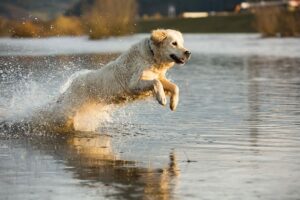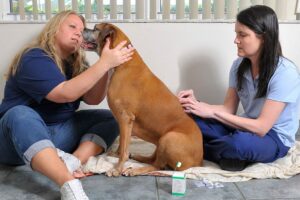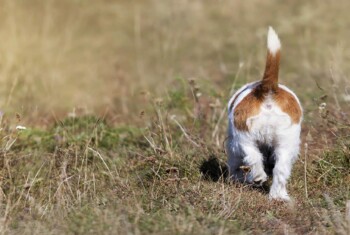Iliopsoas muscle tears: Clinical signs, diagnosis and treatment.
The iliopsoas muscle consists of the fusion of the iliacus and psoas major muscles.
The psoas muscle attaches along the underside of the backbones, and the iliacus attaches on the inner side of the pelvis. These two muscles join together and form a common tendon that attaches onto the lesser trochanter of the thigh bone (femur). The function of this muscle is to externally rotate and flex the hip joint. Animals can function without this muscle.
 Causes.
Causes.
Iliopsoas strain (tear) results from excessive stretching of this muscle during highly athletic activities such as agility training or fetching a tennis ball. The injury occurs commonly at or near the muscle-tendon junction, the weak link.
Slipping into a splay-legged position, jumping off an elevated surface, excessive training or play, and roughhousing with other pets are common causes of muscle strain.
Clinical signs and diagnosis.
Iliopsoas muscle tears are a relatively common yet infrequently diagnosed injury in dogs. Tearing of this muscle is very painful and causes pain and lameness. Commonly, exercise exacerbates the lameness with this condition. Pain is noted when stretching the affected muscle, either by putting the hip in extension with abduction or by putting the hip in extension with internal rotation.
Diagnostic tests.
Radiographs (x-rays) frequently do not show the muscle tear in the acute phase; however, in chronic cases, the torn muscle may have mineralized densities. Ultrasound is a good tool to help diagnose this problem, but sometimes the muscle may only have microscopic changes that may not be seen on ultrasound imaging. MRI and CT scans are other diagnostic tools that can help in the diagnosis of the problem. Commonly, the diagnosis is based on the clinical findings during the examination.
Treatment.
An acute iliopsoas muscle tear should be treated medically; surgery is only reserved for unresponsive cases. Muscle-relaxing medications are used to ameliorate muscle spasms and pain. Other treatments include the administration of nonsteroidal anti-inflammatories (Rimadyl®, Deramaxx™, Previcox®, etc.), applying a cold compress to the groin, and exercise restriction.
Rehabilitation therapy.
Rehabilitation therapy, conducted by a trained professional, is a very important  treatment modality and includes laser therapy to improve the circulation to the muscle and hasten the healing process. Passive range of motion (not too excessive so that it is not painful) helps to maintain flexibility of the muscle.
treatment modality and includes laser therapy to improve the circulation to the muscle and hasten the healing process. Passive range of motion (not too excessive so that it is not painful) helps to maintain flexibility of the muscle.
Overstretching can further tear the muscle and delay healing. Interferential e-stimulation, exercises and progressively increasing the weight bearing of the affected limb are beneficial.
After a few weeks, active range of motion exercises to strengthen the muscles is added to the rehabilitation program. Exercises that strengthen the muscles include cavaletti pole stepping; para standing, which involves lifting the front and hind limbs on the unaffected side; placing the paws on an elevated surface; and wobble board exercises. Acupuncture may also be utilized to help control pain and assist in the healing process.
Chronic strains should not be treated with nonsteroidal anti-inflammatories, as this will prevent activation of the inflammatory process that is needed to reinitiate the healing process.
Rehabilitation by a professional.
Rehabilitation therapy by a professional is essential. Rehabilitation for chronic strains may include heat therapy, deep penetrating ultrasound, cold laser therapy, and massage. Unlike acute tears, chronic tears are treated with stretching and exercise. Recovery from chronic iliopsoas strain takes months. If your companion is an agility dog, weave poles, tight turns and high jumps should be avoided during the early reconditioning period.
To prevent re-injury to the iliopsoas muscle, pre-exercise stretching of the muscle should be done. Extension and abduction of the hip is an excellent stretching exercise for the iliopsoas muscle. In fact, stretching of all muscles is a very good idea for any canine athlete.
Before strenuous activity is initiated, low jumps and wide turns should be done. Stretching with no warm up can be harmful to the muscles and performance of the dog during agility. If time is limited prior to an agility run, a low-impact exercise is more important than stretching. After training or agility performance, cool down exercises are important followed by application of an ice pack to the groin for 5 minutes on, 5 minutes off, and then 5 minutes on.
Surgery.
Surgery is indicated for those dogs that fail to respond to medical treatment or have frequent recurrences. Surgical cutting of the tendon from the femur should not be performed unless the diagnosis has been confirmed with ultrasound imaging, CT scan or MRI. The outcome with surgery is good to excellent; however, working dogs likely will only be able to work at a reduced level to prevent additional injury to other muscles around the hip.


